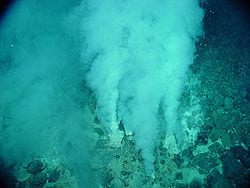In 1977, an expedition set out to the Galápagos Rift to study hydrothermal vents on the ocean floor. They expected the equivalent of an underwater desert, as no sunlight reaches the seafloor at these depths. Instead, they found a thriving biological ecosystem, filled with organisms never seen before. Life seemed to prosper here, and it may even have been where life on Earth first began.
The Origin of Life
Hydrothermal vents are hot springs formed by underwater volcanoes. The ocean crust has fissures in it due to tectonic plate boundaries and ridges, and seawater can move down through these cracks, becoming heated by the magma beneath the surface. The seawater can reach temperatures up to 340˚C, but does not boil due to the high pressures at these depths, instead resurfacing through chimney-like structures, forming hydrothermal vents. The extreme conditions found at these vents have led to the evolution of hyperthermophiles (organisms that can withstand high temperatures) that use chemosynthesis (the use of inorganic compounds instead of sunlight) to provide their energy.
But why do we think this paved the way for life on Earth? The use of 16s rRNA sequencing has been invaluable here. The 16S rRNA gene codes for a small subunit of the ribosome (the molecule responsible for protein synthesis), and is relatively conserved over evolution, with a slow rate of mutations. This makes it useful as a reference to track where two species diverged back in time. By sequencing 16S rRNA genes, a phylogenetic tree can be created, showcasing the evolutionary relationships between all species, and the root of this tree, it was found, were hyperthermophiles and chemoautotrophs – the organisms occupying areas with hypothermal vents. It is these organisms that best represent the Last Universal Common Ancestor (LUCA), from which all life on this planet evolved, and it is at these vents, that they had the environment to develop.

How might life have developed?
One idea suggests that as the super-heated water resurfaced through the vents, molecules in the water may have gotten caught in tiny pores in the rock. These pores could act as cells, where prebiotic chemical reactions could take place, starting the process of life. Another theory suggests life developed by harnessing for energy the pH gradient that occurs when the alkaline seawater gushing from the vent mixes with the more acidic ocean water. This is similar to how modern cells produce energy in the form of ATP, using a proton-motive force.
What does this mean for the future?
The development of life has implications far beyond learning the history of the earth. Knowing how, where and when life developed can better enable us to search for life on other planets, as it would provide us with clues on what to look for. In this way, studying hydrothermal vents is already helping with the search for life in our own solar system, on Jupiter’s moon Europa and Saturn’s moon Enceladus. Both have icy crusts, but underneath are oceans of liquid water, yet both moons are too far away from the Sun for it to provide the energy needed to melt them. Instead, this energy is provided by the gravitational interaction between the moons and their larger planets, as this interaction causes them to heat up inside. This might also provide enough energy to not only melt these oceans but also produce hydrothermal vents on the ocean floor. And, if there are hydrothermal vents, life may have developed.
Whether life did indeed first develop in the depths of the ocean, or somewhere else on the planet, it is clear that these vents provide a unique ecosystem filled with organisms found nowhere else – far from the lifeless desert once thought to be. If nothing else, they showcase the ingenuity and resilience of life, thriving even in the harshest of conditions.

